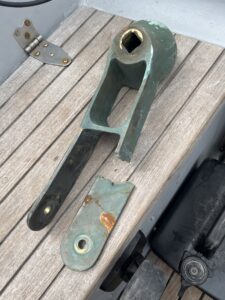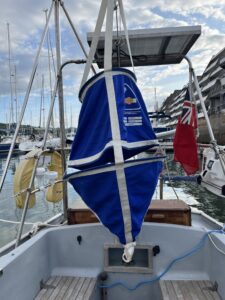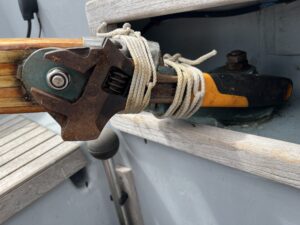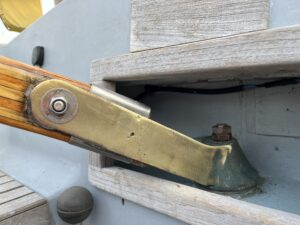It was a bit like waking up on Groundhog Day – every morning, the Windy app showed the same forecast: a whole week of north easterlies.
Well, that was fine. I could stay in Sixhaven marina right in the centre of Amsterdam. I could go to Haarlem on the train and see the Frans Hals Museum – I’d already been to Leiden for the Saturday market and spent whole days following Google Maps down cycle paths and getting lost in the Van Gough Museum.

Best of all, the Aries self-steering was fixed. I was all ready for the start of the Jesters in Plymouth – but that was nearly three weeks away. All I had to do was make sure I got to the West Country sometime in the next month…
If you don’t know about the Jester Challenge, you should: It’s for eccentric (usually eccentric) singlehanders in very small boats who got kicked out of the OSTAR.
In the old days, like when I did the transatlantic back in ‘88, the smallest class – the Jester class – was for boats between 25 and 30ft. It was named after Blondie Hasler’s curious junk-rigged Folkboat, Jester.
But the Royal Western’s race committee, sitting in their expensive hotel accommodation in Newport, Rhode Island, after welcoming all the winners in their big boats, got fed up with waiting a month or more for the little guys to turn up. So, they raised the lower limit to 30ft.
A bunch of the excluded small-boat sailors promptly rebelled: “Sod it, we’ll organise our own event,” they said. “And we won’t have any nonsense about rules and regulations and safety inspections. Or prizes, come to that…”
So, on Sunday, 43 of us will set out simultaneously from Pwllheli and Plymouth to sail to Baltimore in Ireland with no more formality than having to sign a “blood chit” stating that if we sink, it’s our own stupid fault. Last year the destination was Newport – the weather was awful. Nobody got there – but on the other hand, nobody needed to be rescued. They all retired to ports around the Atlantic in seamanlike fashion with dignity intact. Two years before that, it was the Azores in the sunshine.
My boat, Samsara, at 31ft 10in, is technically too big for the Jester (but we know what they think of rules and regulations). Apparently, the skipper’s attitude is more important than overall length.
Besides, this year we will be in Baltimore for the gathering of the O’Driscoll clan. Last time, it was the Pirate Festival. I daresay the Guinness will flow just the same.
There has been only one small insect in the liniment: As I unfolded my bike in Ijmuiden to go and get my stupid black Brexit passport stamped by the immigration office on the other side of town, there was an important-sounding splash as a vital part of the chain tensioning mechanism dropped into the marina.
I walked to the immigration office. It was an hour each way. So that was one reason for stopping in Dover – there’s a Brompton bicycle agent in Folkestone. Also, my friend Patrick could get down to Dover in his camper van for fifteen pints and a curry. According to Windy, I could still get to Plymouth before the north easterlies dissolved into a weekend of calm.
It was with only a small degree of anxiety that I approached Beachy Head 24 hours late, flying along goose-winged with a reef in the main, four rolls in the jib and 80metres of 14mm multiplait in a bight astern to keep us straight. I cooked dinner (kidney bean chipotle with root vegetables and rice), and it was only as I was washing up that I felt the need to pay attention to the Aries and stop us actually bumping into Beachy Head (although more of that later).
Then, I had to go and adjust it again – and I still hadn’t finished washing up.
Adjusting the Aries is a matter of releasing a length of 8mm chain from an attachment on the tiller and fastening it a link or two further along. But this didn’t seem right – the tiller was all the way over to starboard, and there was no weather helm.
It took me an awfully long time to realise that where the tiller was pointing bore no relation at all to where the rudder was pointing. One side of the massive bronze casting which holds the two together had simply snapped in half – and the other side was bent and threatening to give way too.
Essentially, I had lost my steering.

Fortunately, I happen to know all about this. I have rehearsed the “steering failure disaster”.
That is to say, I have rehearsed it in my head. I carry a contraption called a SeaBrake, an Australian device which claims to do everything from getting you over those notorious Queensland harbour bars without broaching – and then stopping the boat from rolling her gunwales under once you’re anchored inside.
It can even be used for emergency steering – just tow it behind the boat with a line to each quarter and pull in the side you want to turn to. You can cross an ocean with a SeaBrake when an Orca bites off your rudder. You can certainly get to Plymouth.
…although, not with 80m of octoplait dragging astern – and with it, as I noticed now that I came to look closely, a large orange fishing float. How did that get there? It appeared to be wrapped around the rope. Anyway, it was kicking up a bow wave fit for a destroyer.
It disappeared as soon as I released one end of the line – which came in laboriously hand over hand and filled the cockpit – also it meant that the boat, with no steering and no drag behind her, started wandering all over the English Channel. I hove to and set about extracting the SeaBrake from its stowage behind the bike in the fo’c’sle. The bike is stowed behind the dinghy (I could tidy up later).

The SeaBrake
The SeaBrake has its own lines (45m, non-stretch) and needs a length of 10mm chain to help it sink – also, a fender on the tail end so that you can get it out of the water backwards when the time comes (I told you I’d thought about this).
It was only after I shackled the chain to the wrong line and rooted around finding the right size cable tie to mouse the pin that I realised this would all be a lot easier without a cockpit full of rope. Believe me, it was a very, very careful old man who set about paying out the warp without getting it round his leg or the gear lever.
Only when the cockpit was clear did I notice the chain lying on the floor, accusingly – not attached to anything.
This meant everything had to come in again. It was while I was cutting another cable tie, finding another shackle – not that one, the pin wouldn’t fit through the links – that my head torch ran out of charge. That’s the thing about rechargeable LED lamps – you don’t get any warning: One minute, bright as day – the next, total darkness,
And silence.
Funny that. The Force 5 that had blown us all the way from Dover seemed to have dropped away completely. Looking for some explanation, the only thing to be seen in the pitch darkness was the glow of the instruments – particularly the depth recorder… showing 1.4m.
Looking ahead, there appeared only total blackness – not a glimmer of horizon. Just the impenetrable black you get from looking at a cliff in the middle of the night,
A cliff so close that you have to look right up in the air to find the top of it.
So, that was what had happened to the wind – it was blanketed completely by Beachy Head. When I hove to, I hadn’t given much thought to which tack I was on. I was three miles offshore and rigging emergency steering wasn’t going to take long, was it?
Well, now we were in 1.4m of water, and Samsara hits the bottom when the little screen says 1.3.
Make it snappy: engine on, reverse – and back out with not a thought for the indignity of the situation.

Beachy Head (by day)
Then back to the job in hand: I think Australians buying the SeaBrake must all have secondary cockpit winches. If you haven’t, how are you supposed to pull in the line on the side you want to turn to?
I was about to get out the handy billy when common sense tapped lightly on the subconscious with a polite suggestion: Would it not be a better idea just to put into Brighton? Maybe the broken tiller would get me that far if I could only find a way to brace it, somehow…
I took a closer look. It was off-centre, but that wouldn’t matter – if I could just strengthen the broken side with something solid – and there’s nothing more solid than the big adjustable spanner: half a kilo of Halfords’ finest (rusty) chrome vanadium. Nothing would bend that.

It was while I was tightening the lashing and tying off the reef knots with my teeth that I looked over the stern – and there, trailing behind the boat like an obedient dachshund, was the servo-rudder of the Aries still tied to its safety line. The sacrificial linkage had snapped.
That was odd. In five years, it had never been subjected to the kind of force to threaten the legendary Aries cast-aluminium strength. Indeed, when I had one on Largo in the 1980s, that never snapped, either.
Maybe the big lobster pot had something to do with it. Hitting that at seven knots would be enough to slam the tiller over pretty hard. It would certainly be enough to pop the servo-rudder.
It was not until two in the morning that everything was squared away, and the big spanner proved that it should always be the first choice in a steering emergency: It took us all the way past Brighton, past St Catherine’s Point, Anvil Point, past Portland Bill, all the way across Lyme Bay. If there was any justice, it should get us into Plymouth on Saturday night before the wind fell light…
Actually, no, it didn’t. Instead, I spent Saturday night anchored in Starehole Bay outside Salcombe, waiting for the “westerly 8kts” promised by the Windy app early on Sunday morning.
Lunchtime found me going backwards, fiddling with the new Super Zero sail in two knots of wind while the Radio 4 forecaster got all excited about this weather pattern being set for the week and 30C in places away from the coast.
Two miles off the coast, there was an “occasional fog bank” with me in the middle of it, listening to the Eddystone’s mournful honking and trying to work out whether I had enough fuel to get into Mayflower Marina without stopping and having to anchor just where HM Harbourmaster says “No Anchoring”.
That was how I came to spend the next night in Hope Cove (which West Country sailors will know is all of ten miles from Starehole Bay). Five thirty the following morning had me rowing ashore with the bike and the empty fuel cans to ride the pretty Devon lanes to the Co-Op filling station at Marlborough.
Oh, I got to Plymouth in the end. Mark at MP Welding found the last brazing rod in Devon, and the rudder and the tiller now agree on where they’re going.
It might make a good story for the other eccentrics in Jolly Jacks.
Or maybe not; I just met a man who sailed from Emden in a 27footer…


Always enjoy reading your updates.
Liam
An enjoyable read, John, albeit at your expense 😉
Priceless John….I look forward to your posts
Wonderful, John . Hope you enjoy the Jester.